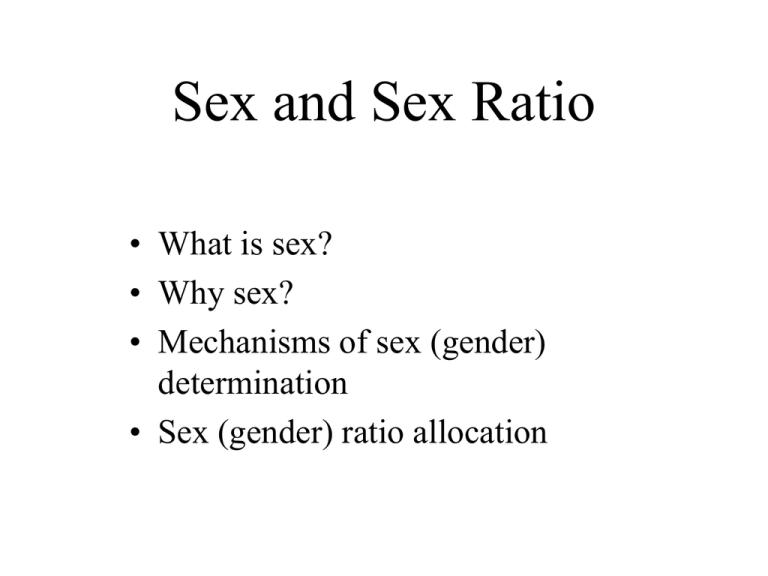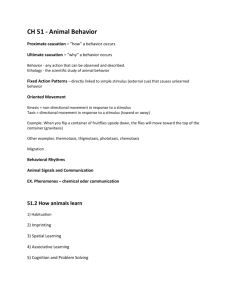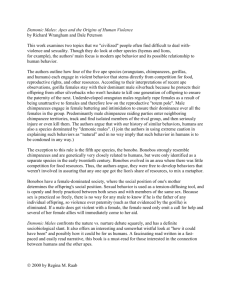
Sex and Sex Ratio
• What is sex?
• Why sex?
• Mechanisms of sex (gender)
determination
• Sex (gender) ratio allocation
What is sex?
Genetic recombination
What determines gender?
Why Sex? The Costs.
1. Cost of males - could produce twice as many females
2. Cost of meiosis - recombination breaks up favorable
gene complexes
3. Finding a mate costs time and energy
Why Sex? The Benefits.
1. Prevents Muller’s Ratchet
–
–
deleterious mutations accumulate in
asexual lineages, not in sexuals
Provides long term benefit
2. Novel gene combinations are created
–
–
Red Queen Hypothesis: need to create
new gene arrangements to combat
pathogen evolution
Provides short term benefit
Host sexuality and parasitism
Freq. of males=sexuals
Trematode infections
• Some spp of snails are both sexual and asexual
• Sexual proportion (freq. of males) increases with
infection by trematode parasites (Lively 1992)
Sex determination
• Types
– Genetic (either chromosomal or genic)
– Environmental
– Social
• Influences the degree to which a female can
alter the sex ratio of her offspring
Chromosomal sex determination
Male heterogamety
Male
XY
Female
XX
Female heterogamety
Female
ZW
Male
ZZ
Distribution of sex
chromosome heterogamety
(numbers of families)
Group
XY males
ZW females XY or ZW
Birds
all
Butterflies
all
Mammals
all
Flies
7
Fish
19
10
2
Lizards
4
3
1
Amphibians
2
3
3
3
Bull, 1983; Solari 1994
Haplodiploidy
• Mechanism
– Haploid males develop from unfertilized eggs
– Diploid females develop from fertilized eggs
• Distribution
– all hymenoptera, thrips, scale insects, some beetles
Creates asymmetries
in relatedness
Environmental Sex Determination
Incubation
temperature
– Terrapins
– Turtles
– Alligators
Social Sex Determination
female
male
• Many fish can undergo
sex reversal
• Depends on mating
system
• Example: dominant
female in Anthias sea
bass harem changes into
male when territorial
male disappears
Sex Ratio Allocation: Null Model
Produce more males
Produce more females
Sex Ratio Allocation: Null Model
• R. A. Fisher: Parental strategies should evolve
towards equal investment in offspring of the two
sexes
• If sex ratio falls below 50%, increased production
of rare sex is favored
• Assuming random mating, rare sex will
experience greater reproductive success
• Frequency-dependent selection leads to a 1:1
stable sex ratio
Adaptive Sex Ratio Bias
•
•
•
•
Maternal condition influences
offspring investment (Trivers-Willard
Effect)
Local mate competition
Local resource competition
Local resource enhancement
Trivers-Willard Effect
• Population sex ratio is 1:1, but individual sex
allocation depends on condition
• If moms in good condition transfer competitive
ability to sons more than daughters (e.g. through
parental care)
• and dominant individuals sire more offspring
• then, they should produce more sons than daughters
• and females in poor condition should produce more
daughters
Condition-dependent sex allocation
in red deer
Dominance dependent sex allocation
in yellow baboons
Dominant females have more daughters than sons
(pass social rank to daughters)
Local Mate Competition
• Mating b/w siblings takes
place near hatching site
• Brothers compete with each
other for mating
• Solution: Produce few sons.
– Expect most offspring of firstlaying female to be daughters
– Expect second-laying female to
adjust sex ratio according to
the proportion of brood that are
hers
• Fig wasps, parasitoid wasps
http://waynesword.palomar.edu/pljune99.htm
Nasonia wasps adjust sex ratio
Line gives theoretical prediction
assuming females contribute
equal numbers of offspring and
adjust sex ratio to maximize
inclusive fitness.
Second laying females adjust sex ratio
proportional to offspring produced
Sex ratio depends on proportion of
eggs that belong to the second female
Local Resource Competition
• Offspring that stay near their
birth site may compete with
their parents for resources
• In many species, one sex
disperses farther or at a greater
rate than the other sex
• Solution: Produce more of the
dispersing sex
• For example, galagos (bush
babies) produce more males
Local Resource Enhancement
• In some spp, offspring of one sex
delay dispersal and remain at the
natal site to help parents raise their
siblings
• Benefits of helpers must be greater
than cost of increased competition
• Ex: Red-cockaded woodpecker
groups are male-biased
– Males help feed young
– Available nesting cavities are rare
Seychelles warbler sex ratios
As territories fill up, females on good
territories produce fewer males
(which disperse) but more females
(which help)












